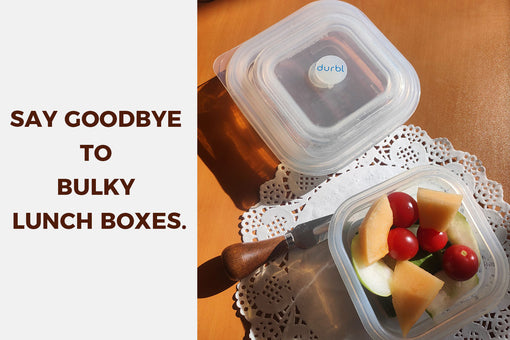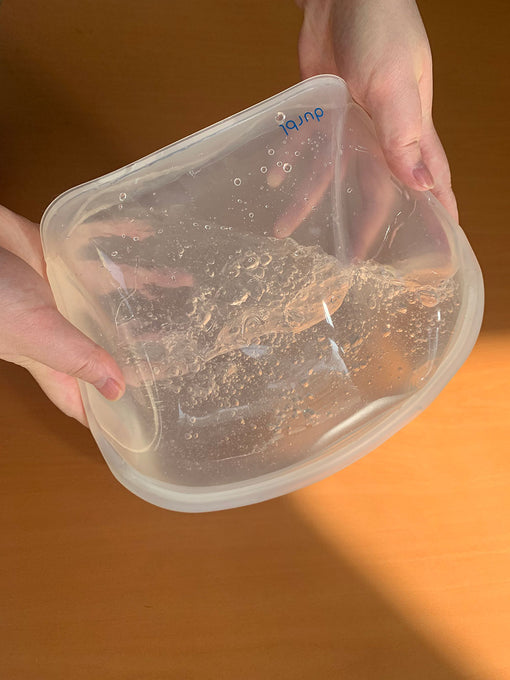In a rented room, with a shared fridge and one office drawer, space gets personal. I chose the Durbl Fold-Up Lunch Box because it’s like a tiny magic button—press once and the volume shrinks. After lunch, I fold it down and suddenly my bag, drawer, and fridge can all breathe again.
Why foldable?
-
Give “air space” back to real space. Fold right after you eat; thickness drops, and you gain usable room above.
-
Modular, tidy stacking. Once folded, every box has the same slim profile—lines up like books, grab-and-go.
-
Perfect for light meals. Salads, sandwiches, sides, fruit—exactly the “office lunch” most of us pack.
Quick facts (no math needed):
Durbl folds to ~43–48% of its open height, freeing ~52–57% of vertical space.

Scene 1|Roommate-friendly “Fridge Tetris”
How I do it
-
Weekend meal prep: 600 ml as the main box (mains/salads), add 400 ml when I want fruit or a snack.
-
After lunch, fold immediately and return it to the same fridge shelf.
What happens
-
On the same shelf, I free up at least two-box heights above the folded stack.
-
Roommates naturally start stacking by layer; the fridge looks calmer and works better.
Scene 2|The One-Drawer Test in a Small Rental Kitchen
Goal: Using just one kitchen drawer, compare how much it holds when boxes are not folded vs folded after lunch.
Measure your setup
-
Drawer inner size: L × W × H
-
Box footprint: l × w, unfolded height h, folded thickness t
Capacity cheat-sheet
-
Flat count per layer ≈ ⌊L ÷ l⌋ × ⌊W ÷ w⌋
-
Layers (unfolded) ≈ ⌊H ÷ h⌋
-
Layers (folded) ≈ ⌊H ÷ t⌋
-
Total capacity = flat count × layers (compare both)
How it feels in real life
-
Not folded: the drawer is “just full.”
-
Folded: suddenly “roomy”—you can still line up the same base layer of boxes, plus tuck in a cutlery pouch / zip bags on the side or stack an extra folded layer.
Small tricks
-
Keep all boxes facing the same way; labels out.
-
Align your cutlery pouch along the long side of the drawer to avoid wasted corners.
-
Put tissues on top with the opening facing outward.
Scene 3|The “Three-Box Workflow” in the Office Cabinet
What I keep
-
600 ml × 3 (mains/salad/fruit or Mon–Wed)
-
1 cutlery set, 1 pack of tissues
-
Optional: thin cutting board, a few zip bags, small condiment packs
How I arrange it
-
A | Left boxes, right extras: three folded boxes stacked on the left; on the right, bottom to top: cutlery → tissues.
-
B | Two levels: base layer of three boxes; extras stacked above. Folding makes the “upper air space” usable.
Why it matters
-
Fold after lunch and your commute bag gets flatter and lighter.
-
Open the drawer and see a uniform slim profile—it saves mental load, too.
Use boundaries & smart habits
-
Best for: salads, sandwiches, pasta, roasted veg, rice + sides, fruit.
-
Skip for: very oily dishes, lots of soup/liquids, carbonated drinks, and piping-hot direct fill. Avoid heavy squeezing.
-
Habits that help:
-
Let hot food cool before sealing.
-
Decant liquids into screw-top bottles.
-
Wash at home together in one go; air-dry completely.
-
My go-to capacity combos
-
Daily: 600 ml (mains/salad) + 400 ml (fruit or yogurt toppings)
-
Overtime / gym days: 600 ml × 2 (mains + protein/veg)
For most light-meal office days, 600 ml is the MVP, and 400 ml is flexible add-on capacity.
5 micro-habits that make folding pay off
-
Fold immediately after lunch.
-
Keep the same orientation; labels facing out.
-
Assign a fixed spot in the fridge/drawer—no searching.
-
Weekend reset: wash → dry → restock.
-
Roommate etiquette: only store what you’ll use this week; fold before putting away.
FAQ
Q1: Will it leak?
For light meals and standard lunches, you’re fine; skip big volumes of soup. Use a dedicated bottle for liquids.
Q2: Microwave-safe?
Follow the brand’s guidance (Durbl’s platinum silicone body is heat-resistant). I personally reheat in a bowl to extend product life.
Q3: Staining?
Tomato and curry can tint silicone—rinse sooner, dry fully. An occasional soak with warm water + baking soda helps.
Q4: Will repeated folding loosen it?
With regular use, shape holds up well. Avoid high heat + rough pulling, and dry thoroughly.
In a roommate world and a city commute, folding isn’t a gimmick—it’s visible order.
Fold after lunch and space comes back; when space comes back, packing lunch becomes easier to stick with.
Start with one small habit today: eat, then fold.




